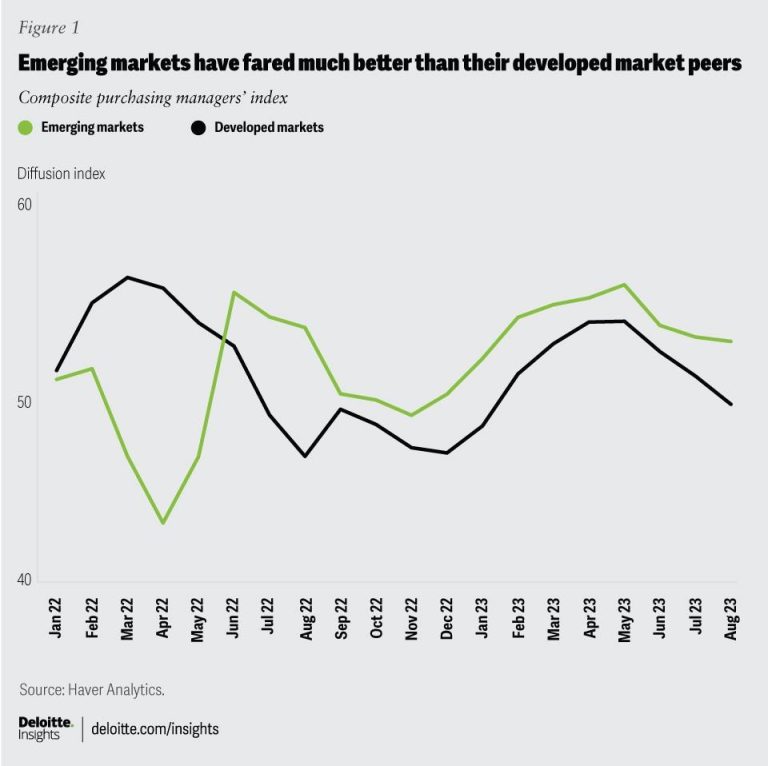Emerging economies are taking the lead in the global upswing as growth in advanced markets cools under the weight of higher borrowing costs and aging populations. From India to Mexico, a reordering of supply chains, a surge in digital adoption, and renewed infrastructure spending are shifting the center of gravity toward faster-growing regions.
Asia’s consumer engines and manufacturing hubs are drawing fresh investment under “China-plus-one” strategies. Latin America is riding nearshoring and commodities tailwinds, while parts of the Middle East and Africa channel energy revenues and demographic momentum into new projects. Portfolio flows and corporate capex are following the trend, signaling a broader recalibration of where and how growth is made.
The momentum is not uniform. Currency volatility, debt burdens, political risk, and climate shocks threaten to puncture optimism. Yet with inflation easing in many markets and reform agendas advancing, investors and multinationals are betting that the next phase of global expansion will be written in emerging markets-and that the story will be as much about domestic demand and services as it is about factories and ports.
Table of Contents
- Capital flows pivot to South and Southeast Asia as domestic demand and supply chain diversification accelerate
- Policymakers focus on infrastructure investment digital inclusion and stable inflation targets to lock in gains
- Investors should tilt toward local currency bonds renewable energy and consumer platforms while hedging dollar risk and governance gaps
- In Conclusion
Capital flows pivot to South and Southeast Asia as domestic demand and supply chain diversification accelerate
Global investors are reweighting toward South and Southeast Asia as robust domestic demand, young labor pools, and the ongoing China+1 reconfiguration reshape production maps; India, Indonesia and Vietnam top new factory and supplier mandates, with Malaysia, Thailand and the Philippines absorbing second-wave components and logistics. Policy reforms, improving infrastructure, and deepening digital finance rails are channeling FDI and portfolio inflows into manufacturing clusters, urban transit, renewables and consumer ecosystems, while steadier external balances and prudential frameworks support currencies and local debt markets-allowing multi‑year capex to proceed despite a higher global rate backdrop.
- Hotspots: India, Indonesia, Vietnam, Malaysia, the Philippines, Thailand.
- Flow mix: Greenfield FDI, supply‑chain capex, portfolio equity into banks/industrials, local‑currency debt.
- Sectors: Electronics assembly, EVs and batteries, renewables, data centers, logistics, consumer platforms.
- Policy signals: Investment incentives, trade pacts, infrastructure corridors, digitized payments and tax rails.
- Risks to monitor: Global rate path, energy costs, FX and liquidity, governance, climate and shipping disruptions.
Policymakers focus on infrastructure investment digital inclusion and stable inflation targets to lock in gains
Governments across key emerging economies are moving to lock in post-pandemic momentum with a synchronized policy mix-channeling capital into ports, power grids, and transit, expanding broadband access and real-time payments, and reinforcing central bank credibility to keep prices anchored-aimed at lifting potential growth while crowding in private finance through PPPs and sovereign green or sustainability-linked bonds.
- Infrastructure pipelines: shovel-ready energy, logistics, and water projects tied to climate resilience and local supply chains.
- Digital inclusion: last-mile connectivity, affordable devices, interoperable digital IDs and payments to formalize SMEs and deepen financial access.
- Stable inflation targets: credible frameworks, transparent communication, and data-dependent easing to anchor expectations.
- Capital discipline: ring-fenced capex, fiscal rules, and transparent procurement to attract long-term investors.
- Execution safeguards: controls on cyber risk, governance, and social impact to sustain public trust.
With election cycles and geopolitics injecting uncertainty, officials argue that combining hard assets, inclusive digital rails, and price stability is the clearest route to convert cyclical rebounds into durable gains.
Investors should tilt toward local currency bonds renewable energy and consumer platforms while hedging dollar risk and governance gaps
Allocators are rotating toward assets tied to domestic cycles-particularly local-currency bonds with elevated real yields, grid-and-storage-heavy renewables, and fast-scaling consumer platforms-while reinforcing defenses against dollar squeezes and uneven governance, a shift driven by easing inflation, policy support for clean energy, and digitization gains across major economies such as Brazil, Mexico, Indonesia, and India.
- Local-currency bonds: Favor markets with credible central banks and steep term premia; mix nominal and inflation-linked debt, barbelled across short and belly maturities to capture carry with controlled duration.
- Renewable energy: Prioritize contracted generation, grid upgrades, storage, and distributed solar; use green bonds and project finance structures that match local-currency revenues with local-currency liabilities.
- Consumer platforms: Focus on payments, logistics, and services with clear unit economics and regulatory visibility; leverage moats from digital public rails (e.g., real-time payments) and insist on robust disclosure and free float.
- Hedging dollar risk: Deploy NDFs and options for currency overlays, maintain hard-currency liquidity buffers, stagger hedge maturities around Fed inflection points, and diversify funding sources.
- Governance safeguards: Demand independent boards, rigorous audits, limits on related-party transactions, and enforceable minority protections; apply governance-adjusted valuation haircuts and avoid opaque cross-holdings.
In Conclusion
Whether the momentum endures will hinge on inflation paths, policy credibility and the cost of capital as global financial conditions shift. Past cycles show how a stronger dollar and sudden stops can test even the most dynamic markets. Yet deeper local capital pools, faster digital adoption and ongoing reforms point to a more durable foundation than in previous upswings.
For investors and policymakers alike, the next phase is about differentiation rather than broad-brush exposure. Country policy mixes, election calendars, energy strategies and supply‑chain positioning will do more to set returns than any single asset class label. If reform and investment pipelines hold, emerging economies could broaden the base of global expansion and cushion slower growth elsewhere. If they stumble, volatility will return. For now, the weight of the recovery is shifting, and the center of gravity for the world’s next leg of growth may be found outside its traditional hubs.


